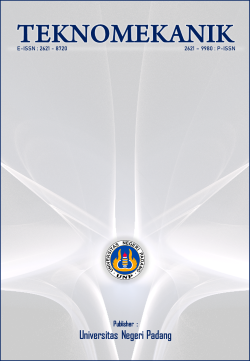Evaluation of the dimensions of the tsunami evacuation path for the community of Air Tawar Barat Village, North Padang District, Padang City, based on geographic information system (GIS)
DOI:
https://doi.org/10.24036/jptk.v4i4.21423Keywords:
Evaluation of the evacuation path, Tsunami, Earthquakes, Network Analyst methodAbstract
Air Tawar Barat Village is included in the High-Risk Zone (area with a high level of vulnerability to tsunamis) in Padang City, so very severe damage likely occurs in the event of a tsunami. The characteristics of the tsunami in Padang City are local tsunamis or short-range tsunamis, where the time interval for tsunami arrivals is between 20-30 minutes. Based on these conditions, a tsunami evacuation route is urgently needed by the community. The current evacuation route is still ineffective because the distance that must be covered is 3-5 km in less than 30 minutes. This study aims to evaluate the evacuation routes that are less effective by comparing the evacuation routes from the government with the results of GIS analysis. The method used in this research is Network Analyst. The results of this study found that the time needed to evacuate was 10 minutes by going to 26 P-TES. Where 24 P-TES are located on the UNP campus, 1 is in the Air Tawar Timur Village and 1 is a planned P-TES. The evacuation route generated from the results of the GIS analysis is more effective than the route from the government because the route to P-TES is closer than having to leave the tsunami zone so that it is more likely to be taken by the community.
Downloads
References
Alhadi, Z. (2014). Kesiapan Jalur Dan Lokasi Evakuasi Publik Menghadapi Resiko Bencana Gempa Dan Tsunami Di Kota Padang (Studi Manajemen Bencana). Humanus, 13(1), 35. Https://Doi.Org/10.24036/Jh.V13i1.4095
Anam, K., Mutholib, A., Setiyawan, F., Andini, B. A., & Sefniwati, S. (2018). Kesiapan Institusi Lokal Dalam Menghadapi Bencana Tsunami: Studi Kasus Kelurahan Air Manis Dan Kelurahan Purus, Kota Padang. Jurnal Wilayah Dan Lingkungan, 6(1), 15. Https://Doi.Org/10.14710/Jwl.6.1.15-29
Andreas, L. O., Andayono, T., Oktaviani, Oktaviani, Zola, P., & Zuwida, N. (2020). Sosialisasi Pemilihan Jenis Pondasi Bangunan Pada Daerah Berpotensi Bencana Di Kecamatan Alam Pauah Duo Kabupaten Solok Selatan. Cived (Journal Of Civil Engineering And Vocational Education), 7(2), 80–84. Https://Doi.Org/10.24036/Cived.V7i2.107183
Ashar, F., Amaratunga, D., & Haigh, R. (2018). Tsunami Evacuation Routes Using Network Analysis: A Case Study In Padang. Procedia Engineering, 212, 109–116. Https://Doi.Org/10.1016/J.Proeng.2018.01.015
Kurniawan, A. A., Sutikno, S., Dosen, R., & Sipil, J. T. (2014). Evaluasi Kapasitas Shelter Evakuasi Untuk Bencana Tsunami Di Kota Padang Berbasis Sistem Imformasi Geografis (Sig). Jurnal Online Mahasiswa (Jom) Bidang Teknik Dan Sains, 1(1), 1–9. Https://Jom.Unri.Ac.Id/Index.Php/Jomfteknik/Article/View/3702
Oktiari, D., & Manurung, S. (2010). Model Geospasial Potensi Kerentanan Tsunami Kota Padang. Jurnal Meteorologi Dan Geofisika, 11(2). Https://Doi.Org/10.31172/Jmg.V11i2.73
Prima, F. K., Gusmareta, Y., Abdullah, R., Rifwan, F., & Zola, P. (2020). Edukasi Konsep Tagana (Tanggap Siap Bencana) Untuk Anak Usia Sekolah Di Daerah Rawan Bencana Kabupaten Solok Selatan Sumatera Barat. Cived (Journal Of Civil Engineering And Vocational Education), 7(2), 58–62. Https://Doi.Org/10.24036/Cived.V7i2.107184
Rifwan, F., Purnawan, P., & Zola, P. (2019). Preferensi Masyarakat Melakukan Evakuasi Jika Terjadi Bencana Tsunami Di Kota Padang. Andalas Civ. Eng. Conf, 933–944.
Schlurmann, T., Kongko, W., Goseberg, N., Natawidjaja, D. H., & Sieh, K. (2011). Near-Field Tsunami Hazard Map Padang, West Sumatra: Utilizing High Resolution Geospatial Data And Reseasonable Source Scenarios. Coastal Engineering Proceedings, 1(32), 26. Https://Doi.Org/10.9753/Icce.V32.Management.26
Suryani, R., Mutia, E., Ellida, D., & Lydia, N. (2020). Evaluasi Rute Evakuasi Tsunami Kecamatan Padang Barat Kota Padang Menggunakan Qgis. Jurnal Media Teknik Sipil Samudra, 1(1), 26–31. Https://Ejurnalunsam.Id/Index.Php/Jmtss/Article/View/2863
Syam, A., & Syam, A. (2016). Kelayakan Jalur Evakuasi Tsunami Di Kecematan Padang Utara Kota Padang. Jurnal Kepemimpinan Dan Pengurusan Sekolah, 1(1), 11–22. Https://Doi.Org/10.34125/Kp.V1i1.3
Takabatake, T., Shibayama, T., Esteban, M., Ishii, H., & Hamano, G. (2017). Simulated Tsunami Evacuation Behavior Of Local Residents And Visitors In Kamakura, Japan. International Journal Of Disaster Risk Reduction, 23, 1–14. Https://Doi.Org/10.1016/J.Ijdrr.2017.04.003
Badan Pusat Statistik (BPS). (2020). Kecamatan Padang Utara Dalam Aangka 2020.
Peraturan Daerah Kota Padang Nomor 4 Tahun 2012. (2012). Rencana Tata Ruang Wilayah Kota Padang Tahun 2010-2030. Peratur. Drh. Kota Padang, 44. Https://Jdih.Padang.Go.Id/Po-Content/Uploads/244. Perda No. 4 Tahun 2012 .Pdf.
Downloads
Published
Issue
Section
License
Copyright (c) 2021 Faisal Ashar, Iqbal Maulana Yusup, Fitra Rifwan, Laras Oktavia Adreas

This work is licensed under a Creative Commons Attribution 4.0 International License.





